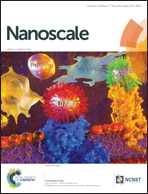Coaxial electrospinning of WO3 nanotubes functionalized with bio-inspired Pd catalysts and their superior hydrogen sensing performance†
Abstract
Macroporous WO3 nanotubes (NTs) functionalized with nanoscale catalysts were fabricated using coaxial electrospinning combined with sacrificial templating and protein-encapsulated catalysts. The macroporous thin-walled nanotubular structures were obtained by introducing colloidal polystyrene (PS) particles to a shell solution of W precursor and poly(vinylpyrrolidone). After coaxial electrospinning with a core liquid of mineral oil and subsequent calcination, open pores with an average diameter of 173 nm were formed on the surface of WO3 NTs due to decomposition of the PS colloids. In addition, catalytic Pd nanoparticles (NPs) were synthesized using bio-inspired protein cages, i.e., apoferritin, and uniformly dispersed within the shell solution and subsequently on the WO3 NTs. The resulting Pd functionalized macroporous WO3 NTs were demonstrated to be high performance hydrogen (H2) sensors. In particular, Pd-functionalized macroporous WO3 NTs exhibited a very high H2 response (Rair/Rgas) of 17.6 at 500 ppm with a short response time. Furthermore, the NTs were shown to be highly selective for H2 compared to other gases such as carbon monoxide (CO), ammonia (NH3), and methane (CH4). The results demonstrate a new synthetic method to prepare highly porous nanotubular structures with well-dispersed nanoscale catalysts, which can provide improved microstructures for chemical sensing.


 Please wait while we load your content...
Please wait while we load your content...